Applied Mathematics and Mechanics (English Edition) ›› 2024, Vol. 45 ›› Issue (2): 337-354.doi: https://doi.org/10.1007/s10483-024-3080-5
• Articles • Previous Articles Next Articles
Haiyang WU, Jiangfeng LOU, Biao ZHANG, Yuntong DAI, Kai LI*( )
)
Received:2023-10-12
Online:2024-02-01
Published:2024-01-27
Contact:
Kai LI
E-mail:kli@ahjzu.edu.cn
Supported by:2010 MSC Number:
Haiyang WU, Jiangfeng LOU, Biao ZHANG, Yuntong DAI, Kai LI. Stability analysis of a liquid crystal elastomer self-oscillator under a linear temperature field. Applied Mathematics and Mechanics (English Edition), 2024, 45(2): 337-354.
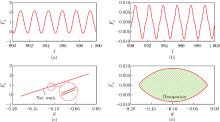
Fig. 3
Self-oscillation mechanism of the system. (a) The time history curve of the driving force for ${\bar a}$0=0.01; (b) the time history curve of the damping force for ${\bar a}$0=0.01; (c) the dependence of the driving force on mass displacement for ${\bar a}$0=0.01; (d) the dependence of the damping force on mass displacement for ${\bar a}$0=0.01 (color online)"


Fig. 4
Effects of the elastic coefficient of the liquid crystal elastomer on the amplitude, frequency, and ε. The parameters are α=-0.38, β=1, ${\bar a}$0 =0.01, ${\bar a}$1 =0.06, and τ=0.01. (a) Effects of the elastic coefficient of the liquid crystal elastomer on the amplitude and ε; (b) effects of the elastic coefficient of the liquid crystal elastomer on the frequency and ε (color online)"
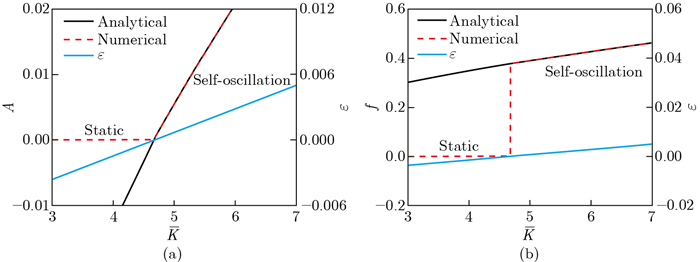

Fig. 5
Effects of the thermal expansion coefficient on the amplitude and frequency with the system parameters of ${\bar K}$=12, β=1, ${\bar a}$0=0.01, ${\bar a}$1=0.06, and τ=0.01. (a) Effects of the thermal expansion coefficient on the amplitude and ε; (b) effects of the thermal expansion coefficient on the frequency and ε (color online)"
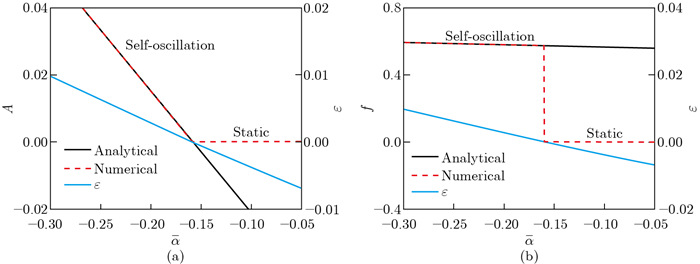

Fig. 6
Effects of the temperature gradient on the amplitude, frequency and ε. The parameters are ${\bar K}$=12, α=-0.38, ${\bar a}$0 =0.01, ${\bar a}$1=0.06, and τ=0.01. (a) Effects of the temperature gradient on the amplitude and ε; (b) effects of the temperature gradient on the frequency and ε (color online)"
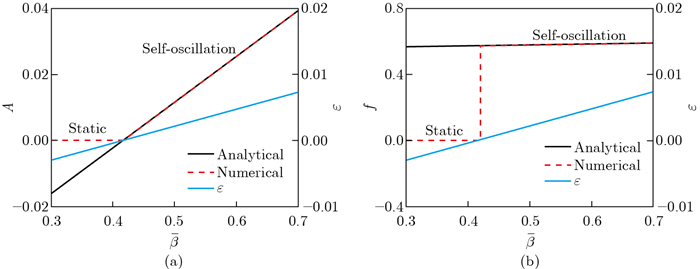

Fig. 7
Effects of the first damping coefficient on the amplitude, frequency, and ε. The parameters are ${\bar K}$=12, α=-0.38, β=1, ${\bar a}$1=0.06, and τ=0.01. (a) Effects of the first damping coefficient on the amplitude and ε; (b) effects of the first damping coefficient on the frequency and ε (color online)"
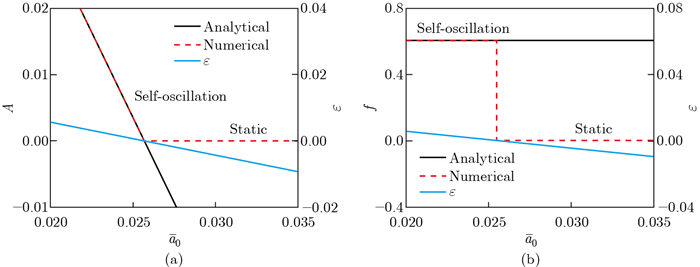

Fig. 8
Effects of the second damping coefficient on the amplitude, frequency, and ε. The parameters are ${\bar K}$=12, α=-0.38, β=1, ${\bar a}$0 =0.01, and τ=0.01. (a) Effects of the second damping coefficient on the amplitude and ε; (b) effects of the second damping coefficient on the frequency and ε (color online)"
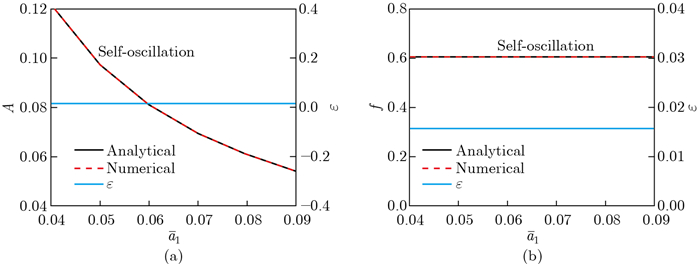

Fig. 9
Effects of the characteristic time on the amplitude, frequency, and ε. The parameters are ${\bar K}$=12, α=-0.38, β=1, ${\bar a}$0=0.01, and ${\bar a}$1=0.06. (a) Effects of the characteristic time on the amplitude and ε; (b) effects of the characteristic time on the frequency and ε (color online)"
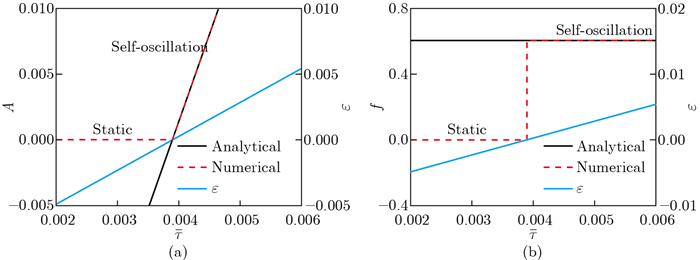
| 1 | LI, M. H., KELLER, P., LI, B., WANG, X., and BRUNET, M. Light-driven side-on nematic elastomer actuators.Advanced Materials,15,569-572(2003) |
| 2 | WANG, X., TAN, C. F., CHAN, K. H., LU, X., ZHU, L., KIM, S., and HO, G. W. In-built thermo-mechanical cooperative feedback mechanism for self-propelled multimodal locomotion and electricity generation.Nature Communications,9,3438(2018) |
| 3 | NOCENTINI, S., PARMEGGIANI, C., MARTELLA, D., and WIERSMA, D. S. Optically driven soft micro robotics.Advanced Optical Materials,6,1800207(2018) |
| 4 | GE, F., YANG, R., TONG, X., CAMEREL, F., and ZHAO, Y. A multifunctional dyedoped liquid crystal polymer actuator: light-guided transportation, turning in locomotion, and autonomous motion.Angewandte Chemie-International Edition,57,11758-11763(2018) |
| 5 | PRESTON, D. J., JIANG, H. J., SANCHEZ, V., ROTHEMUND, P., RAWSON, J., NEMITZ, M. P., LEE, W., SUO, Z., WALSH, C. J., and WHITESIDES, G. M. A soft ring oscillator.Science Robotics,4,5496(2019) |
| 6 | ZENG, H., LAHIKAINEN, M., LIU, L., AHMED, Z., WANI, O. M., WANG, M., and PRIIMAGI, A. Light-fuelled freestyle self-oscillators.Nature Communications,10,1-9(2019) |
| 7 | DING, W. Self-Excited Vibration, Springer-Verlag,Berlin/Heidelberg(2010) |
| 8 | YASHIN, V., and BALAZS, A. Pattern formation and shape changes in self-oscillating polymer gels.Science,314,798-801(2006) |
| 9 | ZHOU, L., DAI, Y. T., FANG, J. G., and LI, K. Light-powered self-oscillation in liquid crystal elastomer auxetic metamaterials with large volume change.International Journal of Mechanical Sciences,254,108423(2023) |
| 10 | SANGWAN, V., TANEJA, A., and MUKHERJEE, S. Design of a robust self-excited biped walking mechanism.Mechanism and Machine Theory,39,1385-1397(2004) |
| 11 | CHENG, Y., LU, H., LEE, X., ZENG, H., and PRIIMAGI, A. Kirigami-based light-induced shape-morphing and locomotion.Advanced Materials,32,1906233(2020) |
| 12 | YANG, L., CHANG, L., HU, Y., HUANG, M., JI, Q., LU, P., LIU, J., CHEN, W., and WU, Y. An autonomous soft actuator with light-driven self-sustained wavelike oscillation for phototactic self-locomotion and power generation.Advanced Functional Materials,30,1908842(2020) |
| 13 | LI, K., ZHANG, B., CHENG, Q., DAI, Y. T., and YU, Y. Light-fueled synchronization of two coupled liquid crystal elastomer self-oscillators.Polymers,15,2886(2023) |
| 14 | CHUN, S., PANG, C., and CHO, S. B. A micropillar-assisted versatile strategy for highly sensitive and effificient triboelectric energy generation under in-plane stimuli.Advanced Materials,32,1905539(2020) |
| 15 | KRIEGMAN, S., BLACKISTON, D., LEVIN, M., and BONGARD, J. A scalable pipeline for designing reconfigurable organisms.Proceedings of the National Academy of Sciences of the United States of America,117,1853-1859(2020) |
| 16 | HU, W., LUM, G. Z., MASTRANGELI, M., and SITTI, M. Small-scale soft-bodied robot with multimodal locomotion.nature,554,81-85(2018) |
| 17 | SHIN, B., HA, J., LEE, M., PARK, K., PARK, G. H., CHOI, T. H., CHO, K. J., and KIM, H. Y. Hygrobot: a self-locomotive ratcheted actuator powered by environmental humidity.Science Robotics,3,ear2629(2018) |
| 18 | LIAO, B., ZANG, H., CHEN, M., WANG, Y., LANG, X., ZHU, N., YANG, Z., and YI, Y. Soft rod-climbing robot inspired by winding locomotion of snake.Soft Robotics,7,500-511(2020) |
| 19 | ZHAO, D., and LIU, Y. A prototype for light-electric harvester based on light sensitive liquid crystal elastomer cantilever.Energy,198,117351(2020) |
| 20 | TANG, R., LIU, Z., XU, D., LIU, J., YU, L., and YU, H. Optical pendulum generator based on photomechanical liquid-crystalline actuators.ACS Applied Materials and Interfaces,7,8393-8397(2015) |
| 21 | WHITE, T. J., and BROER, D. J. Programmable and adaptive mechanics with liquid crystal polymer networks and elastomers.Nature Materials,14,1087-1098(2015) |
| 22 | WU, J., YAO, S., ZHANG, H., MAN, W., BAI, Z., ZHANG, F., WANG, X., FANG, D., and ZHANG, Y. Liquid crystal elastomer metamaterials with giant biaxial thermal shrinkage for enhancing skin regeneration.Advanced Materials,33,2170356(2021) |
| 23 | YOSHIDA, R. Self-oscillating gels driven by the Belousov-Zhabotinsky reaction as novel smart materials.Advanced Materials,22,3463-3483(2010) |
| 24 | HUA, M., KIM, C., DU, Y., WU, D., BAI, R., and HE, X. Swaying gel: chemo-mechanical self-oscillation based on dynamic buckling.Matter,4,1029-1041(2021) |
| 25 | BOISSONADE, J., and KEPPER, P. D. Multiple types of spatio-temporal oscillations induced by differential diffusion in the landolt reaction.Physical Chemistry Chemical Physics,13,4132-4137(2011) |
| 26 | SHEN, Q., TRABIA, S., STALBAUM, T., PALMRE, V., KIM, K., and OH, I. A multiple-shape memory polymer-metal composite actuator capable of programmable control, creating complex 3D motion of bending, twisting, and oscillation.Scientific Reports,6,24462(2016) |
| 27 | WANG, Y., LIU, J., and YANG, S. Multi-functional liquid crystal elastomer composites.Applied Physics Reviews,9,011301(2022) |
| 28 | BUBNOV, A., DOMENICI, V., HAMPLOVÁ, V., KAŠPAR, M., and ZALAR, B. First liquid single crystal elastomer containing lactic acid derivative as chiral co-monomer: synthesis and properties.Polymer,52,4490-4497(2011) |
| 29 | MILAVEC, J., DOMENICI, V., ZUPANČIČ, B., REŠETǏ, A., BUBNOV, A., and ZALAAR, B. Deuteron nmr resolved mesogen vs. crosslinker molecular order and reorientational exchange in liquid single crystal elastomers.Physical Chemistry Chemical Physics,18,4071-4077(2016) |
| 30 | REŠETIČ, A., MILAVEC, J., DOMENICI, V., ZUPANČIČ, B., BUBNOV, A., and ZALAR, B. Stress-strain and thermomechanical characterization of nematic to smectic a transition in a strongly-crosslinked bimesogenic liquid crystal elastomer.Polymer,158,96-102(2018) |
| 31 | KUMAR, K., KNIE, C., BLEGER, D., PELETIER, M. A., FRIEDRICH, H., HECHT, S., BROER, D. J., DEBIJE, M. G., and SCHENNING, A. P. H. J. A chaotic self-oscillating sunlight-driven polymer actuator.Nature Communications,7,11975(2016) |
| 32 | GE, D. L., DAI, Y. T., and LI, K. Light-powered self-spinning of a button spinner.International Journal of Mechanical Sciences,238,107824(2023) |
| 33 | NA, Y. H., ABURAYA, Y., ORIHARA, H., and HIRAOKA, K. Measurement of electrically induced shear strain in a chiral smectic liquid-crystal elastomer.Physical Review E,83,061709(2011) |
| 34 | HABER, J. M., SANCHEZ-FERRER, A., MIHUT, A. M., DIETSCH, H., HIRT, A. M., and MEZZENGA, R. Liquidcrystalline elastomer-nanoparticle hybrids with reversible switch of magnetic memory.Advanced Material,25,1787-1791(2013) |
| 35 | XU, T., PEI, D., YU, S., ZHANG, X., YI, M., and LI, C. Design of MXene composites with biomimetic rapid and self-oscillating actuation under ambient circumstances.ACS Applied Materials and Interfaces,13,31978-31985(2021) |
| 36 | CUNHA, M., PEEKETI, A. R., RAMGOPAL, A., ANNABATTULA, R. K., and SCHENNING, A. Light-driven continual oscillatory rocking of a polymer fifilm.Open Chemistry,9,1149-1152(2020) |
| 37 | HU, Y., JI, Q., HUANG, M., CHANG, L., ZHANG, C., WU, G., ZI, B., BAO, N., CHEN, W., and WU, Y. Light-driven self-oscillating actuators with pototactic locomotion based on black phosphorus heterostructure.Angewandte Chemie-International Edition,60,20511-20517(2021) |
| 38 | SUN, J., HU, W., ZHANG, L., LAN, R., YANG, H., and YANG, D. Light-driven self-oscillating behavior of liquid-crystalline networks triggered by dynamic isomerization of molecular motors.Advanced Functional Materials,31,2103311(2021) |
| 39 | MANNA, R. K., SHKLYAEV, O. E., and BALAZS, A. C. Chemical pumps and flexible sheets spontaneously form self-regulating oscillators in solution.Proceedings of the National Academy of Sciences of the United States of America,118,e2022987118(2021) |
| 40 | LI, Z., MYUNG, N. V., and YIN, Y. Light-powered soft steam engines for self-adaptive oscillation and biomimetic swimming.Science Robotics,6,eabi4523(2021) |
| 41 | HU, Z., LI, Y., and LV, J. Phototunable self-oscillating system driven by a self-winding fiber actuator.Nature Communications,12,3211(2021) |
| 42 | ZHAO, Y., CHI, Y., HONG, Y., LI, Y., YANG, S., and YIN, J. Twisting for soft intelligent autonomous robot in unstructured environments.Proceedings of the National Academy of Sciences of the United States of America,119,e2200265119(2022) |
| 43 | YU, Y., DU, C. S., LI, K., and CAI, S. Q. Controllable and versatile self-motivated motion of a fiber on a hot surface.Extreme Mechanics Letters,57,101918(2022) |
| 44 | HE, Q., WANG, Z., WANG, Y., WANG, Z., LI, C., ANNAPOORANAN, R., ZENG, J., CHEN, R., and CAI, S. Electrospun liquid crystal elastomer microfiber actuator.Science Robotics,6,eabi9704(2021) |
| 45 | LIU, J. X., ZHAO, J. J., WU, H. Y., DAI, Y. T., and LI, K. Self-oscillating curling of a liquid crystal elastomer beam under steady light.Polymers,15,344(2023) |
| 46 | AHN, C., LI, K., and CAI, S. Light or thermally-powered autonomous rolling of an elastomer rod.ACS Applied Materials and Interfaces,10,25689-25696(2018) |
| 47 | BAZIR, A., BAUMANN, A., ZIEBERT, F., and KULI'C, I. M. Dynamics of fiberboids.Soft Matter,16,5210-5223(2020) |
| 48 | SERAK, S., TABIRYAN, N. V., VERGARA, R., WHITE, T., VAIA, R., and BUNNING, T. Liquid crystalline polymer cantilever oscillators fueled by light.Soft Matter,6,779-783(2010) |
| 49 | KUENSTLER, A. S., CHEN, Y., BUI, P., KIM, H., DESIMONE, A., JIN, L., and HAYWARD, R. Blueprinting photothermal shape-morphing of liquid crystal elastomers.Advanced Materials,32,2000609(2020) |
| 50 | GE, D., DAI, Y. T., and LI, K. Self-sustained euler buckling of an optically responsive rod with different boundary constraints.Polymers,15,316(2023) |
| 51 | SHEN, B., and KANG, S. Designing self-oscillating matter.Matter,4,766-769(2021) |
| 52 | CHENG, Q. B., CHENG, W. Y., DAI, Y. T., and LI, K. Self-oscillating floating of a spherical liquid crystal elastomer balloon under steady illumination.International Journal of Mechanical Sciences,241,107985(2023) |
| 53 | XU, P. B, WU, H. Y., DAI, Y. T., and LI, K. Self-sustained chaotic floating of a liquid crystal elastomer balloon under steady illumination.Heliyon,9,e14447(2023) |
| 54 | LU, X., ZHANG, H., FEI, G., YU, B., TONG, X., XIA, H., and ZHAO, Y. Liquid-crystalline dynamic networks doped with gold nanorods showing enhanced photocontrol of actuation.Advanced Materials,30,1706597(2018) |
| 55 | HE, X., AIZENBERG, M., KUKSENOK, O., ZARZAR, L. D., SHASTRI, A., BALAZS, A. C., and AIZENBERG, J. Synthetic homeostatic materials with chemo-mechano-chemical self-regulation.nature,487,214-218(2012) |
| 56 | CHEUNG, Y. K., CHEN, S. H., and LAU, S. L. Application of the incremental harmonic balance method to cubic non-linearity systems.Journal of Sound and Vibration,140,273-286(1990) |
| 57 | YAN, Z., DAI, H., WANG, Q., and ATLURI, S. N. Harmonic balance methods: a review and recent developments.Computer Modeling in Engineering & Sciences,137,1-41(2023) |
| 58 | XIN, Z., and HOU, J. Solution of Duffin system based on normal perturbation method.Journal of Inner Mongolia Normal University,1,31-35(2021) |
| 59 | VESTRONI, F., LUONGO, A., and PAOLONE, A. A perturbation method for evaluating nonlinear normal modes of a piecewise linear two-degrees-of-freedom system.Nonlinear Dynamics,54,379-393(2008) |
| 60 | XIN, Z., and HOU, J. The solution of Duffin system based on Linzteide-Poincare method.Journal of Inner Mongolia Normal University,5,545-550(2022) |
| 61 | WANG, P., and HOU, J. Application of average method to stability analysis of uncertain systems.Journal of Hebei University,1,1-4(2017) |
| 62 | HAN, M. On the maximum number of periodic solutions of piecewise smooth periodic equations by average method.Journal of Applied Analysis & Computation,7,788-794(2017) |
| 63 | FAN, S., and SHEN, Y. Extension of multi-scale method and its application to nonlinear viscoelastic system.Chinese Journal of Theoretical and Applied Mechanics,54,495-502(2022) |
| 64 | MIN, G., LIU, X., YAN, B., SUN, C., and CAI, M. The influence of method of multiple scales and averaging on the galloping characteristics of the crescent iced conductor.Science Technology and Engineering,20,13206-13212(2020) |
| 65 | LI, J., ZHANG, J., ZHANG, W., and LIU, X. Multi-scale methodology for complex systems.Chemical Engineering Science,59,1687-1700(2004) |
| 66 | PANTON, R. Asymptotic analysis methods..Incompressible Flow,374-408(2013) |
| 67 | STURROCK, P. A. Non-linear effects in electron plasmas.Proceedings of the Royal Society of London A,242,277-299(1957) |
| 68 | NAYFEH, A. H. Nonlinear oscillations in a hot electron plasma.The Physics of Fluids 8,10,1896-1898(1965) |
| 69 | ZHU, Y., and CHEN, L. Nonlinear Vibration, Higher Education Press,Beijing(2001) |
| 70 | WEN, B., LI, Y., and HAN, Q. Analytical Methods and Engineering Applications in Nonlinear Vibration Theory, Northeastern University Press,Shenyang(2007) |
| 71 | DING, W. Self-Excited Oscillations in Engineering, Jilin Education Publishing House,Changchun(1988) |
| 72 | ZHOU, L., DU, C. S., WANG, W., and LI, K. A thermally-responsive fiber engine in a linear temperature field.International Journal of Mechanical Sciences,225,107391(2022) |
| 73 | WARNER, M., and TERENTJEV, E. Liquid Crystal Elastomers, Oxford University Press,Oxford(2003) |
| [1] | Hanxiao GUO, Peifeng GAO, Xingzhe WANG. Integrated multi-scale approach combining global homogenization and local refinement for multi-field analysis of high-temperature superconducting composite magnets [J]. Applied Mathematics and Mechanics (English Edition), 2024, 45(5): 747-762. |
| [2] | Jie JING, Xiaoye MAO, Hu DING, Liqun CHEN. Parametric resonance of axially functionally graded pipes conveying pulsating fluid [J]. Applied Mathematics and Mechanics (English Edition), 2024, 45(2): 239-260. |
| [3] | A. V. ROŞCA, N. C. ROŞCA, I. POP. Three-dimensional mixed convection stagnation-point flow past a vertical surface with second-order slip velocity [J]. Applied Mathematics and Mechanics (English Edition), 2023, 44(4): 641-652. |
| [4] | H. B. LANJWANI, M. S. CHANDIO, M. I. ANWAR, S. A. SHEHZAD, M. IZADI. Dual solutions of time-dependent magnetohydrodynamic stagnation point boundary layer micropolar nanofluid flow over shrinking/stretching surface [J]. Applied Mathematics and Mechanics (English Edition), 2021, 42(7): 1013-1028. |
| [5] | Xianghong LI, Jianhua TANG, Yanli WANG, Yongjun SHEN. Approximate analytical solution in slow-fast system based on modified multi-scale method [J]. Applied Mathematics and Mechanics (English Edition), 2020, 41(4): 605-622. |
| [6] | I. WAINI, A. ISHAK, I. POP. MHD flow and heat transfer of a hybrid nanofluid past a permeable stretching/shrinking wedge [J]. Applied Mathematics and Mechanics (English Edition), 2020, 41(3): 507-520. |
| [7] | Naili XU, Hang XU. A modified model for isothermal homogeneous and heterogeneous reactions in the boundary-layer flow of a nanofluid [J]. Applied Mathematics and Mechanics (English Edition), 2020, 41(3): 479-490. |
| [8] | Haohao BI, Bo WANG, Zichen DENG, Shuodao WANG. Effects of thermo-magneto-electro nonlinearity characteristics on the stability of functionally graded piezoelectric beam [J]. Applied Mathematics and Mechanics (English Edition), 2020, 41(2): 313-326. |
| [9] | Yun CUI, Yafei YIN, Chengjun WANG, K. SIM, Yuhang LI, Cunjiang YU, Jizhou SONG. Transient thermo-mechanical analysis for bimorph soft robot based on thermally responsive liquid crystal elastomers [J]. Applied Mathematics and Mechanics (English Edition), 2019, 40(7): 943-952. |
| [10] | Yunyue CONG, Houjun KANG, Tieding GUO. Analysis of in-plane 1:1:1 internal resonance of a double cable-stayed shallow arch model with cables' external excitations [J]. Applied Mathematics and Mechanics (English Edition), 2019, 40(7): 977-1000. |
| [11] | Chuanshi SUN, Shuang LIU, Qi WANG, Zhenhua WAN, Dejun SUN. Bifurcations in penetrative Rayleigh-Bénard convection in a cylindrical container [J]. Applied Mathematics and Mechanics (English Edition), 2019, 40(5): 695-704. |
| [12] | Yadong HUANG, Benmou ZHOU, Zhaolie TANG. Instability of cylinder wake under open-loop active control [J]. Applied Mathematics and Mechanics (English Edition), 2017, 38(3): 439-452. |
| [13] | Ming DONG. Interpretation of gas-film cooling against aero-thermal heating for high-speed vehicles [J]. Applied Mathematics and Mechanics (English Edition), 2016, 37(12): 1615-1630. |
| [14] | Da-ming LI;Xiao-yu LI;Yan-qing LI;R. J. FARAHANI. Flow pattern analysis of linear gradient flow distribution [J]. Applied Mathematics and Mechanics (English Edition), 2015, 36(1): 81-106. |
| [15] | A. FARROKHABADI;A. KOOCHI;A. KAZEMI;M. ABADYAN. Effects of size-dependent elasticity on stability of nanotweezers [J]. Applied Mathematics and Mechanics (English Edition), 2014, 35(12): 1573-1590. |
| Viewed | ||||||
|
Full text |
|
|||||
|
Abstract |
|
|||||


 Email Alert
Email Alert RSS
RSS